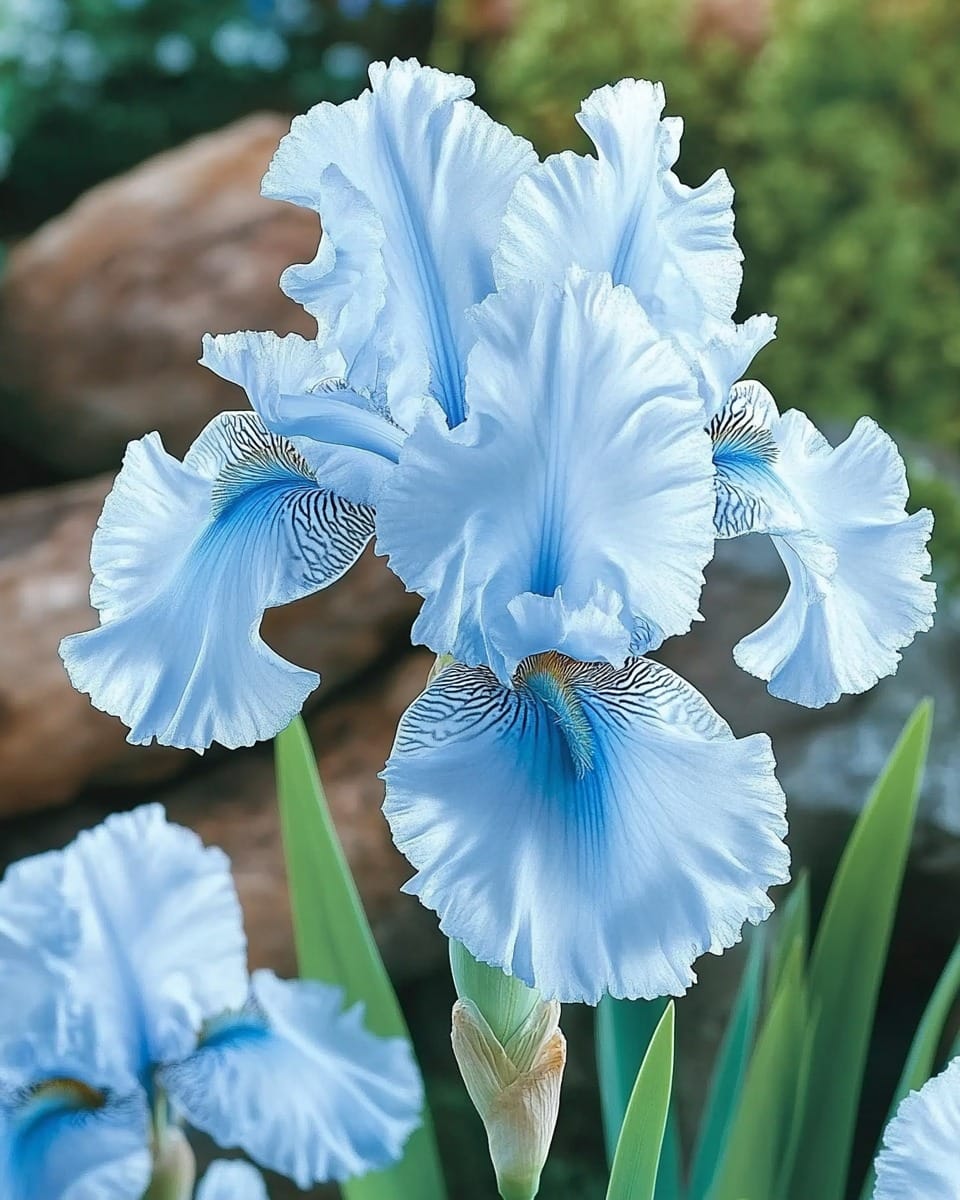The Alpine Blue Iris (Iris brandzae) is a serene and captivating alpine iris variety that shines with its soft, tranquil blue petals. Known for its ability to thrive in cooler climates, this iris is an ideal choice for those looking to add a peaceful and calming presence to their rock gardens or garden borders. The delicate blooms of the Alpine Blue Iris provide a soothing contrast to its surroundings, creating a harmonious balance within the landscape.
Light Requirements:
The Alpine Blue Iris thrives in full to partial sun, making it versatile in garden placements. It can tolerate both direct sunlight and the gentler light that comes from being in partial shade. Ideally, the iris should receive at least 6 hours of sunlight each day to promote healthy blooms, although it will still grow well in slightly shaded spots. When planting, it’s important to ensure the area gets some afternoon shade in warmer climates to protect the plant from scorching heat. This will help maintain the plant’s health and ensure its blooms remain vibrant.
Watering Needs:
The Alpine Blue Iris prefers moderate watering, making it relatively low-maintenance once established. The soil should be kept moist but not soggy, as excessive moisture can lead to root rot or fungal diseases. Water the plant deeply, allowing the soil to dry out between waterings to maintain a balance of moisture. It’s important to note that this iris variety is more drought-tolerant compared to other irises, making it a good option for regions with dry spells. In rainy climates, be sure to plant the iris in a well-draining location to prevent water from accumulating around the roots.
Soil Preferences:
The Alpine Blue Iris thrives in well-draining, rocky or sandy soils. This iris variety has a natural affinity for the rocky, alpine environments in which it originates, which means it prefers soil that drains quickly and doesn’t retain too much moisture. Sandy soils are ideal, but if you have heavier soil, be sure to amend it with gravel, coarse sand, or perlite to improve drainage. Good drainage is essential for the health of this iris, as it prevents the roots from becoming waterlogged. If planting in garden beds, add a layer of gravel or small stones at the base of the planting hole to enhance drainage.
Temperature Tolerance:
The Alpine Blue Iris is best suited for cooler climates, where temperatures typically range from 40°F to 70°F (4°C to 21°C). This iris variety thrives in regions with temperate or cool growing conditions, making it ideal for high-altitude gardens or areas with cooler summers. It’s also resistant to cold temperatures, withstanding mild frosts. However, in regions with extreme heat, it may struggle and require more shade or protection from the midday sun. If you live in a particularly warm climate, try planting the iris in a cool, shaded spot or in containers that can be moved to a more suitable location during the hottest part of the year.
Fertilization:
The Alpine Blue Iris has relatively low nutrient needs and benefits from minimal feeding. If your soil is naturally fertile, additional fertilization may not be necessary. However, to encourage healthy growth and blooming, you can apply a balanced fertilizer in spring, just as the plant begins to emerge from dormancy. Choose a slow-release, balanced fertilizer with an equal ratio of nitrogen, phosphorus, and potassium to promote strong roots, vibrant foliage, and abundant flowers. Over-fertilizing can result in excessive leaf growth at the expense of blooms, so be sure to use fertilizer sparingly.
Planting Tips:
When planting the Alpine Blue Iris, choose a location that receives full to partial sun and has well-draining soil. It’s best to plant the iris in spring, once the danger of frost has passed, so the roots can establish themselves before the heat of summer. Plant the iris rhizomes about 2-3 inches deep and 6-12 inches apart, ensuring that the top of the rhizome is just below the soil surface. For better drainage, consider planting it in a raised bed or on a rocky slope to mimic its natural growing environment.
After planting, water the iris thoroughly to settle the soil around the roots. As the plant establishes itself, it will require minimal care. However, be mindful of weeds, which can compete with the iris for nutrients and water. Mulch around the base of the plant to suppress weed growth and help maintain soil moisture. Avoid covering the rhizomes with mulch, as they prefer to be exposed to the air.
Design Tips:
The Alpine Blue Iris is a fantastic addition to rock gardens, where its delicate, soft blue flowers provide a stunning contrast to rough stones and other low-growing plants. Its compact size also makes it well-suited for garden borders and container gardening. Pair it with other cool-colored plants, such as bluebells, lavender, or white phlox, to create a peaceful and serene garden display.
The Alpine Blue Iris also works beautifully in wildlife gardens, as its elegant blooms attract pollinators such as bees and butterflies. Its gentle beauty can be paired with a variety of native plants, helping to create a natural and tranquil landscape that supports local wildlife.
Conclusion:
The Alpine Blue Iris (Iris brandzae) is a serene and graceful flower that adds a touch of tranquility to any garden. With its delicate blue petals, it offers a peaceful contrast to the bold colors of surrounding plants, making it an excellent choice for rock gardens, borders, and wildlife-friendly landscapes. By providing the iris with the right care—moderate watering, well-draining soil, and minimal feeding—you’ll enjoy its captivating blooms year after year. If you live in a cooler climate, the Alpine Blue Iris is a perfect choice for adding a pop of gentle color to your outdoor space.
More Articles You Might Like
-
Texas Toast Sloppy Joes: The Crunchy, Cheesy Upgrade You Didn’t Know You Needed
There’s something timeless about sloppy joes. For generations, this saucy, savory, and slightly sweet ground beef sandwich has been a go-to comfort food in American kitchens. It’s quick, filling, and family-friendly—perfect for busy weeknights. But what if we told you there’s a way to take this classic dish up a notch? Enter the Texas Toast…
-
Classic Pig Pickin’ Cake
When it comes to Southern desserts, few sweets shine as brightly as the Classic Pig Pickin’ Cake. This nostalgic cake, sometimes called a “Mandarin Orange Cake,” has roots deep in Southern tradition. It gets its playful name from its frequent appearance at pig pickin’s—Southern-style barbecue gatherings where communities come together to enjoy slow-cooked pork, sides,…
-
Lemon Garlic Butter Chicken with Creamy Parmesan Pasta
There’s something irresistible about the combination of tender, golden-browned chicken paired with a creamy pasta coated in Parmesan cheese. Add the brightness of lemon, the depth of garlic, and the richness of butter, and you have a recipe that feels indulgent yet approachable enough for a weeknight dinner. Lemon Garlic Butter Chicken with Creamy Parmesan…



